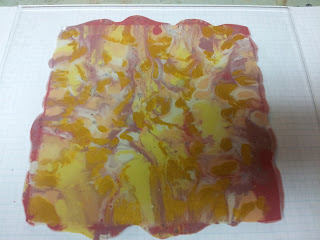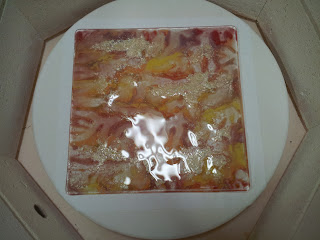I accepted the assignment of creating an award for one of the volunteers who contributes to the website that I work on as a moderator. It was a great opportunity to show off my talents as a glass artist in a broader arena.
The concept came to me - execution was another story. I wanted the words to be in gold, ideally 22k gold. Dream big right?
Since I'm pretty skilled at hand lettering that's what I attempted first... and it looked... hand lettered.
Next thought... I have a buh-zillion years of experience in screen printing. I'll screen print it. But the clock is ticking and I don't have time to reach out to my old screen printing contacts. So, I use my ingenuity and a Michael's coupon to make my own screen
It certainly wansn't the most high tech approach but it worked well! Since I anticipate making another award in a few months I left off the name and date. That much I
CAN hand letter!
With the glass all cut, all I had to do was decide what to use as my medium. I didn't have enough liquid gold, so that wasn't an option. I mulled, contemplated, meditated, and consulted other glass artists - and came up with two possible solutions.
And yes, the clock was still ticking.
I made two phone calls: One to
Clay Art Center - and had a metallic gold Glassline pen on the way; The second was to
Fusion Headquarters - who were sending gold mica powder and screen printing medium.
Since the mica powder was the first to arrive that's what I tried
I was fairly happy with how it printed - the hand lettering worked out great. The real test would be in the firing. Full fuse: 1475° and the lettering was washed out... not enough mica (and I didn't get a pic)
In the meantime the package from Clay Art came. So I tried out the Glassline pen - using the liquid as a screen printing medium and the pen to hand letter the name and date.
I was pleased with how it looked pre-fire. Good, clean print, nice deposit. So in it went, full fuse, 1475°
Imagine my surprise when there was nothing but the ghost of what had been there when I closed the kiln. I can't say I wasn't warned - Kim at Clay Arts said he didn't think it would work... and he was right. But thanks for being so helpful and offering the advice you did!
So, one last attempt with the mica powder. This time I added more powder to the medium - hoping that more pigment would leave a better image when fired.
Though it was a denser print it had also "spread" - not something I was happy with. But hey, that hand lettering sure looks great doesn't it?!
Time to cut my losses and do something else. Laser engraving... I made a 4th glass blank, emailed the file to
Creative Awards and took it to them for engraving. And thanks to Tony Sterling (the recipient) for sending me a photo of the finished award...
I don't consider this a failure... just a learning experience. I haven't found the successful method yet.






















